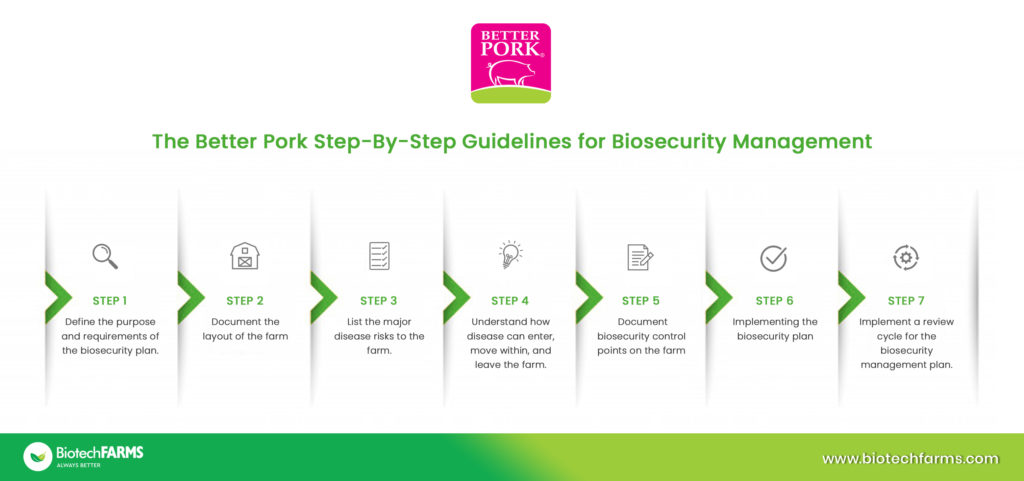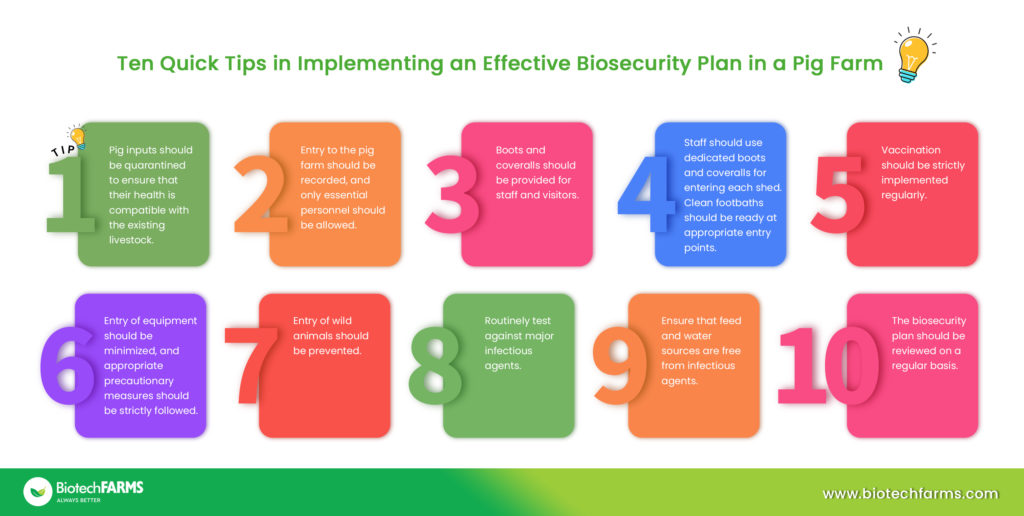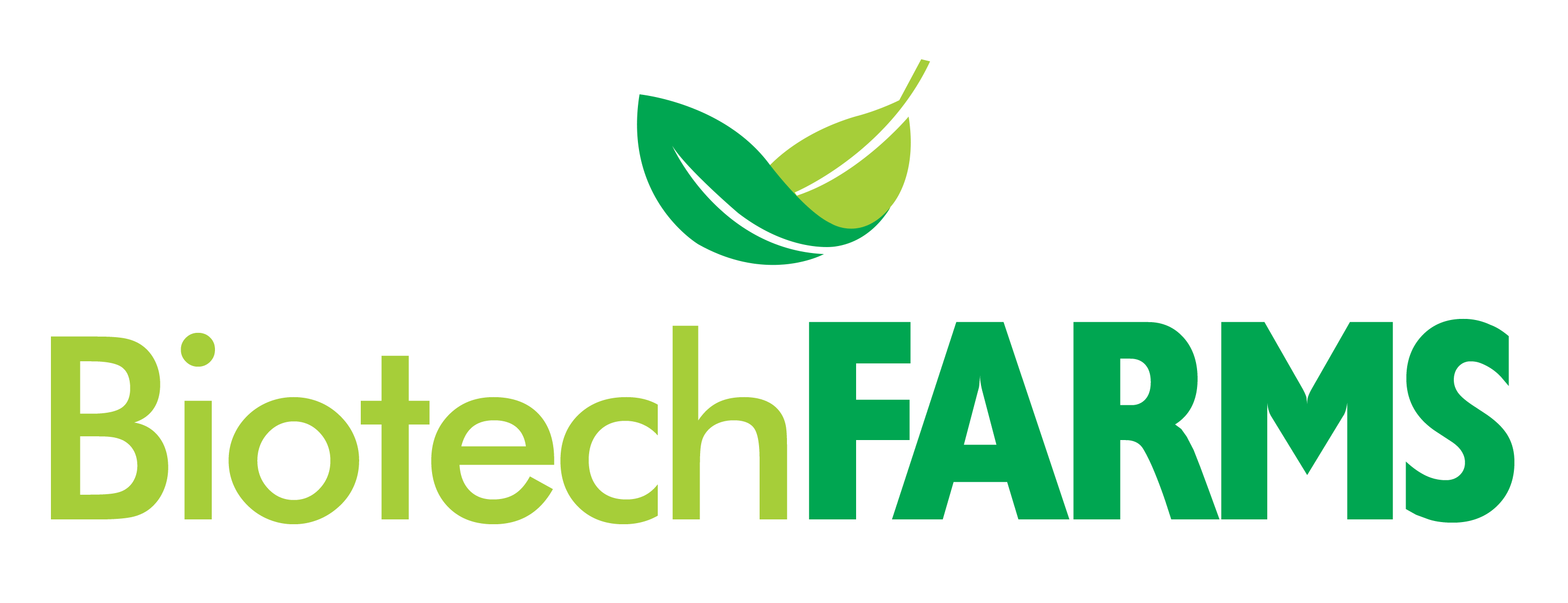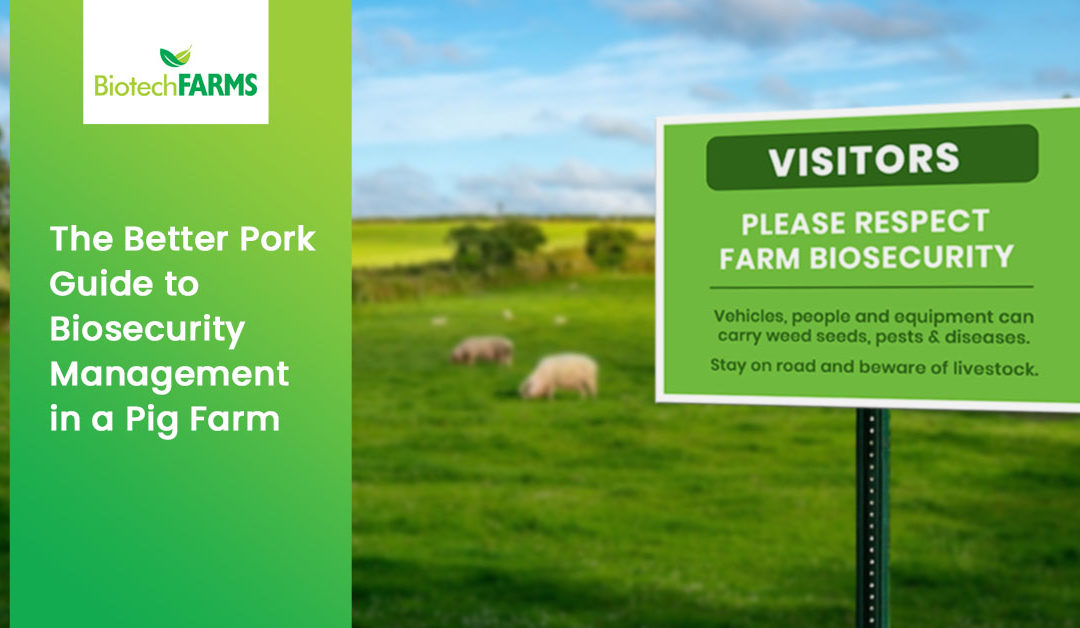Biosecurity in a pig farm refers to the practical measures needed to prevent the entrance of infection in the farm.
The ultimate goal of an effective biosecurity management program is to keep out pathogens that the pigs have not been exposed to by minimizing the impact of endemic pathogens.
Meanwhile, pig farm security refers to the rigorous planning and execution of a program to minimize various types of risk that can have a detrimental effect on the pig farm itself. As such, biosecurity and pig farm security procedures need to be intertwined to enhance the health and productivity of pigs.
The best defense against pests and diseases like the African Swine Fever (ASF) is needed to implement sound biosecurity practices in a pig farm. Whether pigs are kept indoors or outdoors, disease control remains one of the most challenging endeavors for pig farmers.
There are various measures that pig farmers can emulate to help protect their herd. Through its Better Pork brand, Biotech Farms will provide guidelines to help pig farmers identify and implement their own biosecurity practices relevant to the farm.
It should be noted, however, that every biosecurity plan comes with a corresponding investment. As such, ineffective methods need to be prevented. It only takes one minor breach on a farm’s biosecurity to ruin the state of a herd’s health or, much worse, the whole community. Biosecurity management plans are implemented to prevent adverse situations from happening.
Here’s a step-by-step checklist to help you identify the biosecurity strengths and weaknesses of a pig farm.
The Better Pork Step-By-Step Guidelines for Biosecurity Management 
Step 1: Define the purpose and requirements of the biosecurity plan.
Biosecurity plays an integral part in any successful pig farm. It defines the systems in place to protect the farm against infection and disease.
A pig farm biosecurity plan is put in place in order to:
- Reduce diseases introduced in the farm
- Reduce diseases spread within the farm
- Reduce the risk of diseases exiting the farm
- Define emergency response protocols for outbreaks.
An effective biosecurity management plan needs to be tailor-made for specific pig farms. Consequently, a farm-specific biosecurity plan needs a balance of practicality, costs, and all the necessary requirements for implementation.
Step 2: Document the layout of the farm
A detailed map of the farm should include production areas to plan biosecurity controls, training, and responding to an outbreak, should one occur.

Just like the Biotech Farms’ layout of its facilities above, the map should contain the pig farm’s major facilities, such as its buildings, roads, production sheds, fences, guard posts, feeding stations, water tanks, etc.
It is also important to note the pig farm’s biosecurity controls on the map, such as:
- Office reception points for visitors and employees
- Biosecurity points for equipment and vehicle disinfection
- Location of foot baths, shower rooms, and disinfection areas
Step 3: List the major disease risks to the farm.
Prepare a list of biosecurity risks (aka diseases) in your geographical area. It should include diseases known to infect local pig farms and diseases that have previously infected the farm.
Here’s an example of how to document diseases in a pig farm:
| African Swine Fever (ASF) | Description |
| Disease agent | African swine fever virus (ASFV) is a large, double-stranded DNA virus in the Asfarviridae family. It is the causative agent of African swine fever (ASF). |
| Distribution | Occurs worldwide and nationwide in the Philippines. Most prevalent among backyard pig farmers |
| Consequences | ASF causes a hemorrhagic fever with high mortality rates among domestic pigs. Some cases can cause the death of animals as quickly as a week after infection. |
| Transmission | Direct transmission:
Indirect transmission:
Within tick vector:
|
| Further Information | ASF is present in wild or domestic pigs in regions of Asia, Europe, and Africa. The incubation period in nature is usually 4–19 days. |
Step 4: Understand how disease can enter, move within, and leave the farm.
Pathways of Disease
There are several main pathways where diseases can infect a pig farm. The path taken will generally depend on the disease itself and the available vulnerable pathways at the pig farm.
- Direct contact: An infected pig with direct contact with a healthy pig.
- Indirect contact: Disease-causing agents may be found indirectly via fecal matter, oral, or through droplets in the air.
A biosecurity plan aims to put effective controls in place to reduce the existence of these pathways in a pig farm.
Inputs and Carriers of Disease
Viruses and bacteria that can cause disease in a pig farm are not capable of spreading by themselves. The pathways indicated above will still rely on carriers that will transport the disease from animal to animal, human to human, or human to animal.
- Farm Inputs
Almost anything moving in a pig farm can be a potential source of disease for your livestock. Constantly monitor animals or plant materials that enter the pig farm, including sources of water, feed, bedding, and fertilizer.
- People
Remember that if it can move, it can carry diseases, pests, and weeds. As such, people pose a high biosecurity risk and should be managed accordingly,
- Vehicles and Equipment
Diseases, pests, and weeds can enter a pig farm and spread either directly or indirectly through farming equipment and vehicles.
- Production Practices
Effective on-farm biosecurity reduces the risks of spreading diseases. Implement proper hygiene practices for feed, water, storage, waste materials, and livestock propagation activities.
Step 5: Document biosecurity control points on the farm
A biosecurity control point is any location in the farm that inputs should pass through and where farms need to implement disease risk-reducing activities. Summarize how the disease is prevented from entering and exiting biosecurity zones in the farm.
There are several ways of assigning biosecurity control points in a farm, but a simple approach that can work on most farms will be the following:
| ZONE | INCLUSION, DESCRIPTION | CONTROL POINT |
| FARM | Whole-Farm | Shed Gate |
| PRODUCTION | Sheds, ranges, farm equipment and vehicles, storage areas | Office |
| SHED | Each pig shed and its corresponding usage where relevant | Shed Entrance |
| PIG | The livestock, each individual pig | Staff and Quality Assurance |
Step 6: Implementing the biosecurity plan
After listing the control points for disease prevention, employees should implement it daily in the pig farm. Educating employees on the fundamentals and importance of biosecurity is one of the most crucial aspects to take when implementing a biosecurity management plan.
- Staff Training
Staff training and consultation are critical for the effective implementation of the biosecurity plan. Every staff needs to be fully aware of any new responsibilities they have, and they must clearly understand their unique role under the biosecurity management plan.
- Standard Operating Procedures (SOPs)
SOPs aim to support a consistent performance of particular roles or functions by the farm employee. There should be clear and easy-to-follow SOPs within the pig farm so employees can quickly adjust to new routines.
- Checklists and Forms
An effective biosecurity plan needs records that will carry out and reflect the activities implemented on the farm. Managing records should be as simple and practical as possible.
- Equipment
The use and maintenance of all farming equipment need to be supported under the farm’s biosecurity SOPs. If new equipment is to be put in place, the farm staff must understand its proper use and maintenance as per biosecurity guidelines.
- Signage
A pig farm’s newly implemented biosecurity plan may require new signages to be put in place at access points. Proper placement of signages at different areas will help visitors and employees easily identify restricted areas.

Step 7: Implement a review cycle for the biosecurity management plan.
Farm biosecurity needs to be reviewed routinely to continue the prevention of disease infection. If there are instances when changes within the pig farm may impact biosecurity controls, then this should warrant another review of the biosecurity plan apart from its standard review cycle. A routine audit of the plan will ensure that it is being strictly followed, and it can also identify problem areas that need to be improved.
Ten Quick Tips in Implementing an Effective Biosecurity Plan in a Pig Farm

- Pig inputs should be quarantined to ensure that their health is compatible with the existing livestock.
- Entry to the pig farm should be recorded, and only essential personnel should be allowed.
- Boots and coveralls should be provided for staff and visitors.
- Staff should use dedicated boots and coveralls for entering each shed. Clean footbaths should be ready at appropriate entry points.
- Vaccination should be strictly implemented regularly.
- Entry of equipment should be minimized, and appropriate precautionary measures should be strictly followed.
- Entry of wild animals should be prevented.
- Routinely test against major infectious agents.
- Ensure that feed and water sources are free from infectious agents.
- The biosecurity plan should be reviewed on a regular basis.
Biotech Farms and Better Pork take food safety and security seriously.
Implementing a pig farm’s biosecurity management plan needs a lot of work and dedication to be effective. At Biotech Farms, we adhere to our biosecurity protocols consistently and adequately.
We understand that behind every farm’s success is the prevention of the entry of diseases. To provide the best quality of pork to our customers, we consider biosecurity as an investment essential for the safety of animals, farmworkers, and the general public.
Get started with your own biosecurity plan today.
References:
Biosecurity Guidelines for Piggery. (n.d.). Department of Animal Husbandry & Dairying | Government of India. https://dahd.nic.in/sites/default/filess/Biosecurity%20guidelines%20for%20piggery.pdf
Board, N. (2021). Biosecurity of Pigs and Farm Security – Pork Information Gateway. Retrieved 25 May 2021, from https://porkgateway.org/resource/biosecurity-of-pigs-and-farm-security/
Farmers, F., & Resources, F. (2021). Biosecurity – Australian Eggs. Retrieved 25 May 2021, from https://www.australianeggs.org.au/for-farmers/resources/biosecurity
Pigs – Farm Biosecurity. (2021). Retrieved 25 May 2021, from https://www.farmbiosecurity.com.au/industry/pigs/


